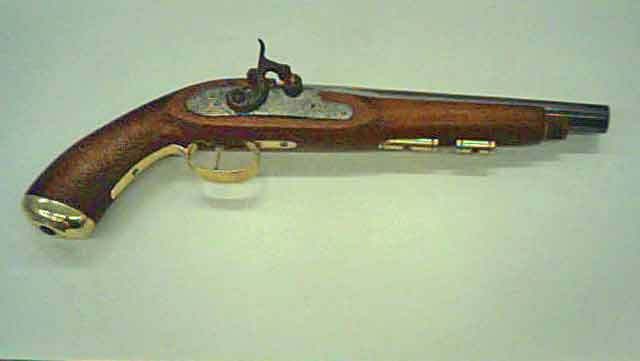Yes, well after 200 odd posts here, I finally own a muzzleloading pistol that I got off of a friend for 20 bucks. It's a CVA tower pistol that needs some work. The wood is in decent shape (maybe good enough to leave alone). I will take some pictures of this gun later tonight hopefully. It does have some issues, and I'm lookingi for suggestions.
1) Barrel looks like it was browned, but it has some pretty serious rust. What should I strip it down with to get it nice and white again? I"m thinking of starting with some gentle steel wool, but that sounds slow. I'm very hesitant to just chuck it in the glass bead cabinet though...
2) Brass is really corroded up- I think I can fix this on my own with some of this polish I used to use when I bought .223 ammo by the belt (my dad, brother, and I would sit around the fire back in PA and seperate and polish the individual cartriges with this stuff).
3) The delicate engraving on the lock is pretty messed up. It might just be some fouling, but I suspect there is some rust there as well. I'm very hesitant to use anything to rough around this area, so I'm really thinking steel wool to clean it all up with, and lots and lots of patience...
4) The ramrod needs to be rifinished. I'm sure I can be a little rougher on the ramrod, but how should a ramrod be refinished? Does it get browned or blued to match the gun, or what should I do with it?
5) The buttplate doesn't seem to fit up properly to the butt- the plate protrudes out to the side of the butt. I haven't taken it apart to really look at it, but what can be done to fix this, without messing up the countersinking on the screw that holds the buttplate on?
Anyway this is for starters. There are other issues with this gun that will need to be addressed, but the above is about the worst of it. I'm not too sure how to go about taking it apart, but I think I have a good enough idea to be careful anyway...'
Your thoughts and advaice are greatly appreciated. Thanks!
1) Barrel looks like it was browned, but it has some pretty serious rust. What should I strip it down with to get it nice and white again? I"m thinking of starting with some gentle steel wool, but that sounds slow. I'm very hesitant to just chuck it in the glass bead cabinet though...
2) Brass is really corroded up- I think I can fix this on my own with some of this polish I used to use when I bought .223 ammo by the belt (my dad, brother, and I would sit around the fire back in PA and seperate and polish the individual cartriges with this stuff).
3) The delicate engraving on the lock is pretty messed up. It might just be some fouling, but I suspect there is some rust there as well. I'm very hesitant to use anything to rough around this area, so I'm really thinking steel wool to clean it all up with, and lots and lots of patience...
4) The ramrod needs to be rifinished. I'm sure I can be a little rougher on the ramrod, but how should a ramrod be refinished? Does it get browned or blued to match the gun, or what should I do with it?
5) The buttplate doesn't seem to fit up properly to the butt- the plate protrudes out to the side of the butt. I haven't taken it apart to really look at it, but what can be done to fix this, without messing up the countersinking on the screw that holds the buttplate on?
Anyway this is for starters. There are other issues with this gun that will need to be addressed, but the above is about the worst of it. I'm not too sure how to go about taking it apart, but I think I have a good enough idea to be careful anyway...'
Your thoughts and advaice are greatly appreciated. Thanks!











